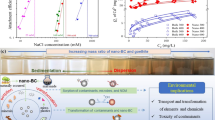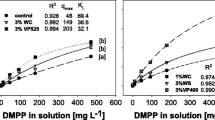Abstract
Black carbon (BC) can act as a catalyst to promote the reductive transformation of redox-sensitive organic chemicals in electron-rich conditions. This process is called a BC-mediated reduction. To determine the effects of natural organic matter and the existence of soil on the BC-mediated reduction of nitroaromatics (NACs) in subsurface environments, a BC-mediated reduction of 2,4-dinitrotoluene (DNT) by dithiothreitol was investigated using graphite, humic acid (HA), and soil. The presence of dissolved HA in the graphite–dithiothreitol–DNT system showed different yields of reduction intermediates and pathways, indicating that different reduction/removal mechanisms are involved. Control experiments with HA alone confirmed that the HA-mediated reduction of DNT and HA–DNT complexation are existed. Kinetically, HA did not slow the reductive removal of DNT in the graphite–dithiothreitol system. In contrast, the existence of soil in the system retarded the BC-mediated reduction of DNT, probably due to competitive sorption and hindrance of mass transfer. Our results suggest that the amounts of BC and HA may affect the BC-mediated reduction of NACs in soils and sediments.






Similar content being viewed by others
References
Accardi-Dey A, Gschwend PM (2002) Assessing the combined roles of natural organic matter and black carbon as sorbents in sediments. Environ Sci Technol 36:21–29
Amezquita-Garcia HJ, Razo-Flores E, Cervantes FJ, Rangel-Mendez JR (2013) Activated carbon fibers as redox mediators for the increased reduction of nitroaromatics. Carbon 55:276–284
Chiu CT, Malcolm RL, Brinton TI, Kile DE (1986) Water solubility enhancement of some organic pollutants and pesticides by dissolved humic and fulvic acids. Environ Sci Technol 20:502–508
Cornelissen G, Gustafsson Ö (2005) Importance of unburned coal carbon, black carbon, and amorphous organic carbon to phenanthrene sorption in sediments. Environ Sci Technol 39:764–769
Curtis GP, Reinhard M (1994) Reductive dehalogenation of hexachloroethane, carbon tetrachloride, and bromoform by anthrahydroquinone disulfonate and humic acid. Environ Sci Technol 28:2393–2401
Dunnivant FM, Schwarzenbach RP (1992) Reduction of substituted nitrobenzenes in aqueous solutions containing natural organic matter. Environ Sci Technol 26:2133–2141
Gauthier TD, Shane EC, Guerin WF, Seltz WR, Grant CL (1986) Fluorescence quenching method for determining equilibrium constants for hydrocarbons binding to dissolved humic materials. Environ Sci Technol 20:1162–1166
Guo X, Jans U (2006) Kinetics and mechanisms of the degradation of methyl parathion in aqueous hydrogen sulfide solution: investigation of natural organic matter effects. Environ Sci Technol 40:900–906
Kappler A, Haderlein SN (2003) Natural organic matter as reductant for chlorinated aliphatic pollutant. Environ Sci Technol 47:2714–2719
Kemper JM, Ammar E, Mitch WA (2008) Abiotic degradation of hexahydro-1,3,5-trinitro-1,3,5-triazine in the presence of hydrogen sulfide and black carbon. Environ Sci Technol 42:2118–2123
Li AZ, Marx KA, Walker J, Kaplan DL (1997) Trinitrotoluene and metabolites binding to humic acid. Environ Sci Technol 31:584–589
Lohmann R, MacFarlane JK, Gschwend PM (2005) Importance of black carbon to sorption of native PAHs, PCBs, and PCDDs in Boston and New York harbor sediments. Environ Sci Technol 39:141–148
Magee BR, Lion LW, Lemley AT (1991) Transport of dissolved organic macromolecules and their effect on the transport of phenanthrene in porous media. Environ Sci Technol 25:323–331
Nguyen TH, Sabbah I, Ball WP (2004) Sorption nonlinearity for organic contaminants with diesel soot: method development and isotherm interpretation. Environ Sci Technol 38:3595–3603
Nurmi JT, Tratnyek PG (2002) Electrochemical properties of natural organic matter (NOM), fractions of NOM, and model biogeochemical electron shuttles. Environ Sci Technol 36:617–624
Oh SY, Chiu PC (2009) Graphite- and soot-mediated reduction of 2,4-dinitrotoluene and hexahydro-1,3,5-trinitro-1,3,5-triazine. Environ Sci Technol 43:6983–6988
Oh SY, Son JG, Lim OT, Chiu PC (2012) The role of black carbon as a catalyst for environmental redox transformation. Environ Geochem Health 34:105–113
Oh SY, Son JG, Hur SH, Chung JS, Chiu PC (2013a) Black carbon-mediated reduction of 2,4-dinitrotoluene by dithiothreitol. J Environ Qual 42:815–821
Oh SY, Son JG, Chiu PC (2013b) Biochar-mediated reductive transformation of nitro herbicides and explosives. Environ Toxicol Chem 32:501–508
Pignatello JJ, Kwon S, Lu Y (2006) Effect of natural organic substances on the surface and adsorptive properties of environmental black carbon (char): attenuation of surface activity by humic and fulvic acids. Environ Sci Technol 40:7757–7763
Qiu Y, Xiao X, Cheng H, Zhou Z, Sheng GD (2009) Influence of environmental factors on pesticide adsorption by black carbon: pH and model dissolved organic matter. Environ Sci Technol 43:4973–4978
Rebhun M, Meir S, Laor Y (1998) Using dissolved humic acid to remove hydrophobic contaminants from water by complexation-flocculation process. Environ Sci Technol 32:981–986
Struyk Z, Sposito G (2001) Redox properties of standard humic acids. Geoderma 102:329–346
Van der Zee FP, Cervantes FJ (2009) Impact and application of electron shuttles in the redox (bio)transformation of contaminants: a review. Biotechnol Adv 27:256–277
Wershaw RL, Burcar PJ, Goldberg MC (1969) Interaction of pesticides with natural organic matter. Environ Sci Technol 3:271–273
Xu W, Dana KE, Mitch WA (2010) Black carbon-mediated destruction of nitroglycerin and RDX by hydrogen sulfide. Environ Sci Technol 44:6409–6415
Xu W, Pignatello JJ, Mitch WA (2013) The role of black carbon conductivity in mediating hexahydro-1,3,5-trinitro-1,3,5-triazine (RDX) transformation on carbon surfaces by sulfides. Environ Sci Technol 47:7129–7136
Yu X, Gong W, Liu X, Shi L, Han X, Bao H (2011) The use of carbon black to catalyze the reduction of nitrobenzenes by sulfides. J Hazard Mater 198:340–346
Acknowledgments
This research was supported by the 2015 research fund of University of Ulsan, South Korea.
Author information
Authors and Affiliations
Corresponding author
Rights and permissions
About this article
Cite this article
Oh, SY., Son, JG. The effects of humic acid and soil on black carbon-mediated reduction of 2,4-dinitrotoluene. Environ Earth Sci 75, 79 (2016). https://doi.org/10.1007/s12665-015-4826-4
Received:
Accepted:
Published:
DOI: https://doi.org/10.1007/s12665-015-4826-4




